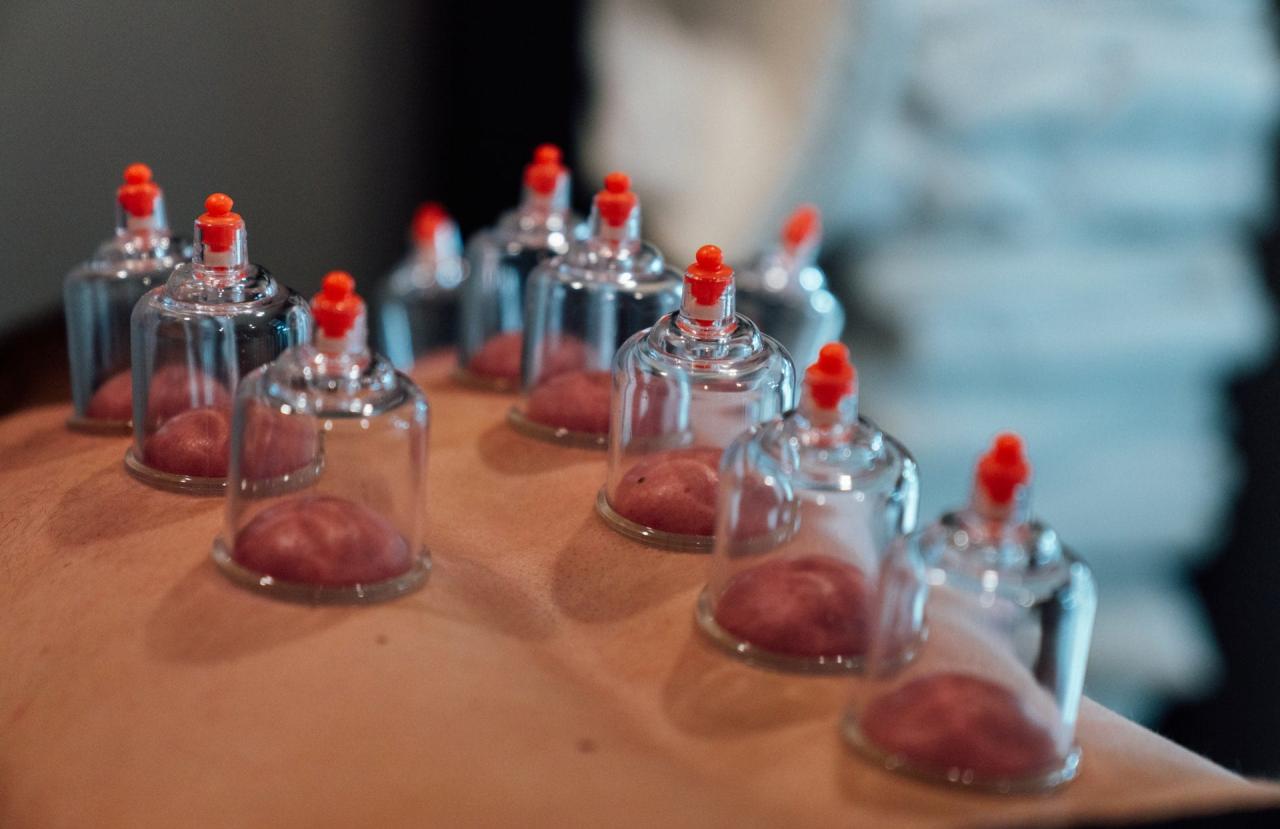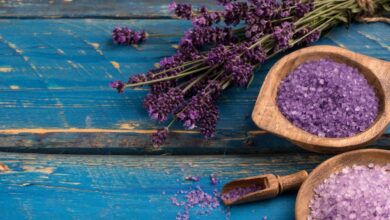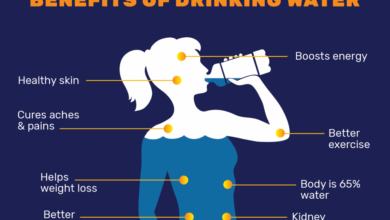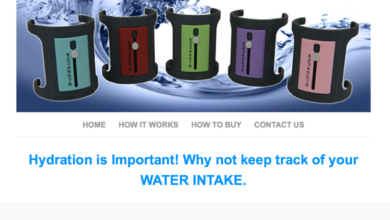
Cupping is Trending, But Does It Help Recovery?
Cupping is trending but does it help recovery – Cupping is trending, but does it help recovery? This question has sparked heated debate among athletes, wellness enthusiasts, and even casual observers. The practice of cupping, which involves placing heated glass cups on the skin to create suction, has been around for centuries.
But its recent surge in popularity, thanks in part to celebrity endorsements, has left many wondering if it’s just another fleeting fad or a legitimate recovery tool.
From ancient Chinese medicine to modern-day sports therapy, cupping has been used for a wide range of purposes, including pain relief, muscle recovery, and detoxification. Proponents swear by its effectiveness, citing anecdotal evidence and personal experiences. But the scientific community remains divided, with some studies showing promising results while others raise concerns about its safety and efficacy.
Cupping

Cupping therapy, an ancient practice that involves placing heated glass cups on the skin to create suction, has gained significant popularity in recent years. This resurgence of interest in cupping can be attributed to its perceived benefits for pain relief, muscle recovery, and overall well-being.
History and Origins of Cupping Therapy
Cupping therapy has a rich history dating back thousands of years, with evidence of its use found in ancient civilizations across the globe. In traditional Chinese medicine, cupping is believed to stimulate blood flow, release toxins, and promote healing.
Ancient Egyptians, Greeks, and Middle Eastern cultures also employed cupping techniques for various ailments.
Types of Cupping Techniques
There are several different types of cupping techniques, each with its own unique application and benefits:
- Dry Cupping:This technique involves placing heated glass cups on the skin, creating suction as the air inside the cup cools and contracts.
- Wet Cupping:This technique involves making a small incision on the skin before applying the heated cup. The suction draws out a small amount of blood, which is believed to release toxins and improve circulation.
- Bamboo Cupping:This technique uses bamboo cups instead of glass cups, offering a more gentle and less invasive approach.
Celebrities and Athletes Using Cupping
Cupping therapy has gained widespread recognition in recent years, particularly among athletes and celebrities. High-profile athletes like Michael Phelps and Olympic gymnast Alex Naddour have been seen with cupping marks on their bodies, raising awareness of this ancient practice.
Popularity of Cupping Therapy
The popularity of cupping therapy has been steadily increasing in recent years. A 2018 survey by the National Center for Complementary and Integrative Health (NCCIH) found that 4.3% of adults in the United States had used cupping therapy in the past year.
So, everyone’s talking about cupping these days, but does it really help with recovery? I’m still on the fence about it, but I do know that a healthy diet is crucial for any kind of recovery. That’s why I’m always on the lookout for tasty and nutritious meals, and I recently discovered 11 healthy pizzas under 400 calories ! Maybe a pizza night could be the perfect fuel for a post-cupping session?
Or maybe I’m just trying to justify indulging in my favorite food. Either way, I’m definitely going to give those healthy pizzas a try.
This number is expected to continue to rise as more people become aware of the potential benefits of this ancient practice.
How Cupping Works
Cupping is an ancient practice that involves placing heated glass cups on the skin to create suction. This suction draws blood and other fluids to the surface of the skin, creating a localized area of redness and bruising. While it may look a bit intimidating, cupping is actually a safe and effective treatment that has been used for centuries to treat a variety of conditions.
The Physiological Mechanisms Behind Cupping
Cupping therapy works by creating a vacuum within the cup, which pulls the skin and underlying tissues upward. This suction can have a number of effects on the body, including:* Increased blood flow and circulation:The suction created by the cups helps to draw blood and other fluids to the surface of the skin, improving circulation in the area.
Reduced inflammation The suction can also help to reduce inflammation by drawing out toxins and other inflammatory substances.
Muscle relaxation The suction can help to relax muscles and relieve muscle tension.
Pain relief
Cupping is a hot topic right now, but does it really aid in recovery? While it might offer temporary relief, sustainable change comes from addressing the root of the issue. This is where lifestyle adjustments come in, and I’ve found that focusing on simple, everyday changes can make a world of difference.
Check out this great article on 10 Simple Changes That Lead to Weight Loss for some inspiration. These changes, like eating a balanced diet and incorporating regular exercise, can have a far greater impact on overall health and recovery than any temporary treatment.
So, while cupping might be trendy, it’s essential to consider the long-term strategies that truly support your well-being.
Improved lymphatic drainage The suction can help to improve lymphatic drainage, which can help to remove waste products from the body.
Cupping’s Effects on Blood Flow and Circulation
The suction created by cupping draws blood and other fluids to the surface of the skin, improving circulation in the area. This increased blood flow can help to deliver oxygen and nutrients to the tissues, as well as remove waste products.
Cupping is often used to treat conditions that are associated with poor circulation, such as:* Muscle cramps:The increased blood flow can help to relax muscles and relieve cramps.
Numbness and tingling The increased blood flow can help to improve circulation and reduce numbness and tingling.
Cold hands and feet The increased blood flow can help to warm up the extremities.
Cupping and Muscle Recovery
Cupping is often used to promote muscle recovery after exercise or injury. The increased blood flow can help to deliver oxygen and nutrients to the muscles, as well as remove waste products. This can help to reduce muscle soreness and stiffness, and promote healing.
Cupping’s Role in Reducing Inflammation
Cupping can help to reduce inflammation by drawing out toxins and other inflammatory substances. The suction created by the cups can help to improve lymphatic drainage, which can help to remove waste products from the body. Cupping is often used to treat conditions that are associated with inflammation, such as:* Arthritis:The increased blood flow and reduced inflammation can help to relieve pain and stiffness associated with arthritis.
Tendonitis The increased blood flow and reduced inflammation can help to heal tendonitis.
Muscle strains The increased blood flow and reduced inflammation can help to heal muscle strains.
Scientific Evidence on Cupping for Recovery
While cupping has been used for centuries, its effectiveness for muscle soreness and recovery is still being investigated. Research on the topic is growing, but more studies are needed to provide definitive conclusions.
Research on Cupping for Muscle Soreness
Studies on cupping’s effect on muscle soreness have produced mixed results. Some research suggests that cupping may help reduce muscle soreness and improve recovery time after exercise. For example, a 2018 study published in the Journal of Traditional and Complementary Medicine found that cupping therapy reduced muscle soreness and improved range of motion in participants who engaged in strenuous exercise.
However, other studies have found no significant benefit from cupping for muscle soreness.
Comparison of Cupping with Other Recovery Methods
It’s important to compare cupping to other common recovery methods like massage and stretching. Massage therapy is a well-established recovery method that can improve blood flow, reduce muscle tension, and alleviate pain. Stretching helps increase flexibility and range of motion, which can also reduce muscle soreness.
Potential Limitations and Biases in Existing Research
Several limitations and biases may affect the results of cupping research. One limitation is the small sample sizes in many studies. Additionally, some studies may have methodological flaws, such as a lack of control groups or inadequate blinding procedures.
Furthermore, the quality of cupping techniques and the experience of practitioners can vary significantly, which can influence the effectiveness of the treatment.
Need for Further Scientific Investigation
Despite the existing research, more rigorous scientific investigation is needed to fully understand the effects of cupping for recovery. Future studies should focus on larger sample sizes, standardized cupping techniques, and rigorous methodological designs. It is crucial to address potential biases and limitations in current research to provide a more comprehensive understanding of cupping’s effectiveness for muscle soreness and recovery.
Risks and Considerations of Cupping
While cupping can be a beneficial therapy for some, it’s essential to understand the potential risks and considerations before undergoing treatment. Like any other medical procedure, cupping carries certain risks, and it’s crucial to approach it with caution and informed consent.
Potential Risks of Cupping
Cupping, while generally considered safe, can have some side effects, although they are usually mild and temporary. The most common risk associated with cupping is bruising. The suction created by the cups can cause blood to pool under the skin, resulting in circular marks that can last for several days.
In some cases, these marks may be more prominent or even painful. Another potential risk is burns. If the cups are left in place for too long or if the heat from the cups is too intense, it can cause burns on the skin.
This risk is higher with fire cupping, where the cups are heated with a flame before being applied to the skin.
Importance of Consulting a Qualified Practitioner, Cupping is trending but does it help recovery
It is crucial to consult a qualified and experienced practitioner before undergoing cupping therapy. A qualified practitioner will be able to assess your individual needs and determine if cupping is appropriate for you. They will also be able to advise you on the appropriate technique, duration, and frequency of treatment.
Cupping is all the rage these days, but does it actually help with recovery? While the jury’s still out on that, one thing that’s definitely good for your body is eating plenty of vegetables. Check out these 5 ways to up your vegetable game to boost your overall health.
And who knows, maybe a healthy diet will help you recover from whatever ails you, whether it’s muscle soreness or just the general wear and tear of life.
Guidelines for Choosing a Reputable Cupping Therapist
When choosing a cupping therapist, it’s important to consider the following factors:
- Experience and Qualifications:Look for a therapist who is licensed and certified in cupping therapy and has experience treating a wide range of conditions.
- Reputation and Reviews:Check online reviews and testimonials from previous clients to get an idea of the therapist’s reputation and effectiveness.
- Communication and Comfort:Choose a therapist who is easy to communicate with and who makes you feel comfortable and confident in their abilities.
Contraindications for Cupping Therapy
There are certain conditions that may make cupping therapy inappropriate or even dangerous. These contraindications include:
- Bleeding Disorders:Individuals with bleeding disorders, such as hemophilia, should avoid cupping as it can increase the risk of bleeding.
- Skin Infections:Cupping should not be performed on areas of the skin that are infected or inflamed.
- Pregnancy:While there is limited research on the safety of cupping during pregnancy, it is generally recommended to avoid it, especially during the first trimester.
- Certain Medical Conditions:Individuals with certain medical conditions, such as osteoporosis, anemia, or heart conditions, should consult their doctor before undergoing cupping therapy.
Cupping in Different Contexts
Cupping, a therapeutic technique that involves applying heated glass cups to the skin, has gained popularity in various contexts beyond its traditional use in traditional Chinese medicine. This versatile practice offers a range of potential benefits, from promoting relaxation and improving circulation to aiding in recovery from injuries.
This section explores the diverse applications of cupping in different contexts, providing insights into its potential role in enhancing overall well-being.
Cupping in Sports and Activities
Cupping has found a place in the world of sports and physical activity, where athletes seek to optimize performance and expedite recovery. Here’s a table illustrating the use of cupping in various sports and activities:| Sport/Activity | Benefits of Cupping ||—|—|| Running|
- Improves blood flow to muscles
- Reduces muscle soreness and stiffness
- Enhances recovery time |
| Swimming|
- Improves flexibility and range of motion
- Relaxes tight muscles
- Reduces muscle fatigue |
| Weightlifting|
- Promotes muscle recovery
- Increases blood flow to injured areas
- Reduces pain and inflammation |
| Yoga|
- Enhances flexibility and range of motion
- Promotes relaxation and stress relief
- Improves circulation |
| Martial Arts|
- Improves flexibility and range of motion
- Reduces muscle soreness and stiffness
- Promotes relaxation and focus |
Cupping for Different Types of Injuries
Cupping can be a valuable tool in managing various injuries, providing pain relief, reducing inflammation, and promoting healing.* Muscle Strains and Sprains:Cupping can help to improve blood flow to the injured area, reduce muscle spasms, and promote tissue repair.
Back Pain Cupping can be applied along the spine to relieve muscle tension, improve circulation, and reduce pain.
Neck Pain Cupping can be used to alleviate muscle tension in the neck, improve range of motion, and reduce headaches.
Shoulder Pain Cupping can help to relieve muscle tension, improve circulation, and reduce pain in the shoulder.
Knee Pain Cupping can be used to reduce inflammation, improve blood flow, and promote healing in the knee joint.
Integrating Cupping into a Holistic Wellness Approach
Cupping can be effectively integrated into a holistic wellness approach, complementing other therapies and practices to promote overall well-being.* Stress Reduction:Cupping can promote relaxation and reduce stress levels by stimulating the release of endorphins.
Improved Sleep Quality Cupping can help to alleviate muscle tension and promote relaxation, leading to improved sleep quality.
Enhanced Immune Function Cupping can stimulate the lymphatic system, which helps to remove toxins and boost the immune system.
Increased Energy Levels Cupping can improve circulation and oxygenation, leading to increased energy levels.
Personal Anecdotes and Testimonials
“After years of suffering from chronic back pain, I finally found relief with cupping therapy. The sessions helped to loosen up my tight muscles and reduce inflammation, allowing me to move more freely and pain-free.”
Sarah, a cupping therapy client.
“As a marathon runner, I’ve found that cupping helps to speed up my recovery time after intense training sessions. It reduces muscle soreness and stiffness, allowing me to get back to training faster.”John, a marathon runner.
Final Review: Cupping Is Trending But Does It Help Recovery
Whether you’re a seasoned athlete looking for an edge or someone seeking a natural way to alleviate pain, understanding the potential benefits and risks of cupping is crucial. While the evidence is still developing, it’s clear that cupping is not a one-size-fits-all solution.
Consulting with a qualified healthcare professional can help you determine if cupping is right for you and guide you towards a personalized approach to recovery and wellness.






